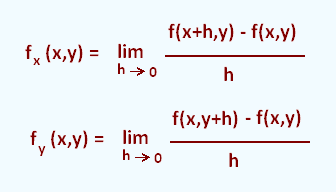Calculus III
Contents
3 Dimensional space
Partial derivatives
Multiple integrals
Vector Functions
Line integrals
Surface integrals
Vector operators
Applications
© The scientific sentence. 2010
|
|
Calculus III:
Partial Derivatives
Derivatives of functions of more than one variable
Changing one of the variables
First order partial derivatives.
1. Defnitions and rule
Recall that, given a function of one variable, f(x) , its derivative, f'(x), represents the rate of change of the function as x changes.
For functions of more than one variable, one can change only one, or
more than one variables.
Partial derivative means changing one of the variables at a time, while the remaining variable(s) are held fixed.
Just as with functions of one variable, we can have first order partial derivatives, as well as derivatives of all orders.
With functions of a single variable f(x), we denote the derivative with a single prime f'(x). However, with partial derivatives we, need to specify the variable that we are differentiating with respect to.
We subscript the variable that we differentiate with respect to
fx(x,y).
Here is the rule:
To compute fx(x,y), we treat all the y�s as constants (or numbers) and then differentiate the x�s. Likewise, to compute fy(x,y), we treat all the x�s as constants and then differentiate the y�s as we are used to doing.
f(x) → f'(x) = df/dx (ordinary derivative)
f(x,y) → fx(x,y) = ∂f(x,y)/∂x, and
fy(x,y) = ∂f(x,y)/∂y (partial derivative)
2. Changing one of the variables
Let's take the following example: f(x, y) = 2 x2y3
Let�s start with the function and let�s determine the rate at which the function is changing at a point, (a, b) , if we hold y fixed and allow x to vary and if we hold x fixed and allow y to vary.
• First case: Holding y fixed and allowing x to vary.
If we hold y fixed and allow x to vary, the rate of change of the function f(x, y)
at the point (a, b) will involve only the variable x, and y remains
equal to b. So we get then a new function of a single variable:
g(x) = 2b3 x2
Therefore, the rate of change of f(x,y) at (a,b) is the rate of change
of g(x) at the point x = a, that is g'(a).
For this function of a single variable , we know how to derive:
g'(a) = 4b3 x
This is called the partial derivative of f(x,y) with respect to x at the point (a,b) .
We write:
fx(a,b) = ∂f(x,y)/∂x = 4 a b3
• Second case: Holding x fixed and allowing y to vary.
In a similar way,
If we hold x fixed and allow y to vary, the rate of change of the function f(x, y)
at the point (a, b) will involve only the variable y, and x remains
equal to a. So we get then a new function of a single variable:
h(x) = 2a2 y3
Therefore, the rate of change of f(x,y) at (a,b) is the rate of change
of h(x) at the point y = b, that is h'(y).
For this function of a single variable , we know how to derive:
g'(b) = 6 a2 b2
This is called the partial derivative of f(x,y) with respect to y at the point (a,b) .
We write:
fy(x,y) = ∂f(x,y)/∂y = 6 a2 b2
Using the standard notion, we have then:
fx(x,y) = ∂f(x,y)/∂x = 4xy3
fy(x,y) = ∂f(x,y)/∂y = 6x2y2
3. Formal definition of the partial derivative
The definition of fx(x,y) and fy(x,y)is similar to the definition of the derivative for single variable functions.

4. Examples
Example 1
f(x,y) = 2x2y + y
fx(x,y) = ∂f(x,y)/∂x = 4xy
fy(x,y) = ∂f(x,y)/∂y = 2x2 + 1
Example 2
Find ∂y/∂x for 2y3 + x2 = 3x
6y2 ∂y/∂x + 2x = 3
∂y/∂x = (3 - 2x)/ 6y2
|
|